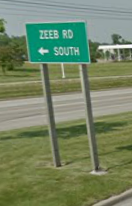(*/Special_roads/Main*/) |
Kentsmith9 (talk | contribs) m (Kentsmith9 moved page Michigan/Test/Special roads/Main to Michigan/Special roads/Main: Pre) |
(No difference)
| |
Revision as of 23:30, 29 January 2015
(DRAFT) Median U-Turn Intersection (MUTI)
- NOTE: Although these guidelines have not officially been adopted as a Waze standard, the discussion is occurring at this forum thread. This section is in place as a guide for editors experimenting with this type of intersection while a consensus is being reached statewide or country-wide.
A Median U-Turn Intersection (MUTI) is a procedure involving an indirect left turn onto or from a split roadway onto another road where the direct left turn is prohibited at the intersection itself. A MUTI can only occur at the intersection with a cross street. Other median u-turns may be available at crossovers along a split road, however these would not be classified as MUTI since they simply facilitate going the opposite direction along the same split road. A reference figure showing both types of u-turns together appears below.
To execute the turn, the driver proceeds through the intersection to turn left at the next median u-turn, then turns left onto the same road (in the opposite direction), and finally turns right at the main intersection. Alternatively, if the intersection involves turning onto a split cross road, the driver could also turn right onto the intersecting split road, then turn left at the median u-turn, finally turning left onto the road and proceeding through the main intersection.
This procedure has proliferated in Michigan since the late 1960's, and is locally referred to as a “Michigan Left Turn (MLT)” or just “Michigan Left“, even in locations other than Michigan. The MUTI and its variants are now used or being considered in several states and other countries.
Other terms for this procedure in transportation literature from the Federal Highway Administration and individual states include:
- “Arizona Parkway”
- “Boulevard Turnaround”
- “Median U-Turn Crossover”
- “Median U-Turn Intersection Treatment (MUTIT)”
- “ThrU-Turn Intersection (TTI)”
In addition, there are a number of related procedures directed toward the same or a similar result as the MUTI. Consequently, some of these procedures may need treatment similar to the MUTI in Waze:
- "Continuous Flow Intersection (CFI)"
- “J-turn”
- “Jughandle”
- “Reduced Conflict Intersection (RCI)”
- “Restricted Crossing U-Turn Intersection (RCUT)”
- “Super-Street Median Crossover”
In order to be considered a MUTI (or variant), proper signage should be in place. Depending on what entity maintains the road, however, the quality of signage will vary.
- Naming Convention: to [street name] [opposing direction] / to [cross street name] [direction]
- Similar to highway way-finder segments, the “street name” is instructional rather than official
- Example intersection of Mound Rd and Metro Parkway in Macomb County
- Driving north on Mound Rd: "to Mound Rd S / to Metro Pkwy W"
- Driving south on Mound Rd: "to Mound Rd N / to Metro Pkwy E"
- Driving west on Metro Pkwy: "to Metro Pkwy E / to Mound Rd S"
- Driving east on Metro Pkwy: "to Metro Pkwy W / to Mound Rd N"
- Road Type: RAMP
- Although this departs from traditional rules for At-grade connectors and for use of the ramp road type, it hides the instructional street name in the client. It is close to the exception stated on the at-grade connector page, however, in that a MUTI is a signed--though unnumbered--exit from the current direction of travel on a roadway.
- Junction Angles: Between 45 and 90 degrees
- The angles for the median u-turn should generate two "turn left" instructions. The first “turn left” should occur prior to entering and the second should occur while exiting the median crossover.
- Junction Position:
- The initial junction ideally should be as close to the start of the solid white line as possible (if present). This prevents a turn instruction from occurring too early or too late. In many cases, this will require adding a geometry node at the start of the segment at the most detailed zoom level to generate the correct turn angle.
Sample MUTI as it appears in Waze Map Editor:
Distinction between MUTI and standard crossovers:
Alleys
As a general rule in Michigan, only residential alleys should be mapped, and only if they are the locally accepted destination for parking at or near a residence. Alleys should only function as a starting point or final destination, not as a thoroughfare. If alleys are mapped, the road type should be set to "Parking Lot Road" and given the name "Alley". Other attributes (city, direction, turn restrictions) should be set as if the alley were any other drivable road.
When adding or editing an alley, an important consideration is to verify that house numbers are properly situated for the surrounding street segments. Waze will route to the closest segment for a set of destination coordinates. This may result in the destination being in the alley, which may or may not be the desired result. Refer to the FAQ for additional information. If you need guidance or are uncertain whether a certain alley would meet the criteria to be mapped, please post a permalink in this existing Michigan forum thread.




